|
|
 |
|
|
 |
Monday, June 20, 2005 Montreal to Ste. Anne de Bellevue
37.4 miles today/2152 total Loop miles
3 locks to rise 53 feet/33 total Loop locks
Remember our plodding progress upriver to Montreal yesterday? Today we set a speed record as we headed
downriver -- fourteen miles per hour!
We got to the first of our two St. Lawrence Seaway locks within about a half hour of leaving the Montreal
Marina, but we had to wait an hour to go in, because they were preparing the lock for a commercial vessel, and commercial
vessels get priority locking on the Seaway.
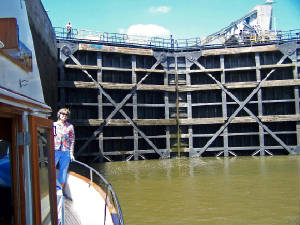
|
| Locking up in the St. Lawrence Seaway |
All fifteen of the Seaway locks are the same jumbo size -- 766 feet long and 80 feet wide -- to accomodate
massive freighters, which have a maximum length of 730 feet. As we made our way into the lock and its gates closed behind
us, we felt like we were riding a little toy boat in a very big bathtub.
The lock holds 21 million gallons of water, and it can be filled in just ten minutes. We got the fast
fill in the second lock -- it felt like we were going up an elevator. In the first lock, we had a leisurely ride up,
probably because they knew a long slow train was approaching the railroad lift bridge over the lock doors they had to open
for us to continue. So we sat and waited, watching the train and reading "Tommy Trent's ABCs of the Seaway," a booklet
for kids that the lock tenders gave us after we paid our $20 lockage fee. The booklet provided more interesting information
than most of the glossy brochures for adults we have picked up for the other locks. (It's the source for all the lock
statistics provided in this section.)
The Seaway segment we traveled was mostly a narrow canal, with a six miles per hour speed limit. We
passed one of those 730 foot freighters port-to-port in close quarters, but hardly felt a wake because of the slow speed.
A bike trail runs along a berm beside the canal, and lots of riders raced by us.
We emerged from the canal into the broad Lac St. Louis, and departed from the Seaway Channel. No more
big boats to worry about until Chicago, Dick promised me.
The shores of Lac St. Louis are lined with beautiful homes on a much larger scale and with more opulent
designs and amenities than any homes we've yet seen in Canada. We could see Montreal in the distance five hours after
we left -- our route took us in a wide circle.
We arrived at Ste. Anne de Belleville mid-afternoon. A long wall with space for about twenty boats
runs along the town waterfront right before the small historic Ste. Anne Lock, and a park on the opposite side of the
canal has a dock about the same length. Restaurants with tables beneath bright awnings or umbrellas line the town shore,
where diners can watch the passing parade of boatrs. Lots of pleasure boaters were tied up to the wall, enjoying the sun and
each other. We passed this lively area and went through the lock (up three feet) to tie up at a much shorter wall
just on the other side of the lock, at the mouth of the Ottawa River. Even though this spot was less
sheltered from waves and weather, and out of the festive waterfront attraction atmosphere, it had the big advantage of allowing
us to move on early the next morning. If we stayed on the other side of the lock, we couldn't leave until the first
lockage at 9 am.
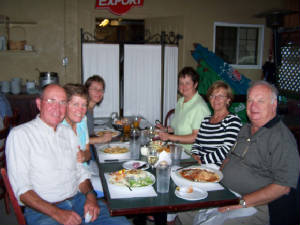
We had a wonderful treat in Ste. Anne. We met up with Louise and Jacque Sauve, Palm Beach Harbour
Club friends of Dad. This time of year, they live on the water about a half hour from Ste. Anne's. They are enthusiastic
boaters and very warm and generous people. Louis and Jacque came aboard Starsong, shared great photos and tips
from their recent voyage on the Trent Severn Waterway, and loaned us a special cruising guide for that area their son-in-law
custom-made for them, reflecting lots of internet and tourism resource research. Then they took us out to dinner
at a great Italian restaurant on the Ste. Anne waterfront.
Their daughter Nicole and her friend Linda live nearby, so they hopped on their boat, zipped up to
the dock, and joined us for dinner. They brought their log of favorite places they have visted along the Rideau
Canal, and I took lots of notes on the back of a placemat. Both Nicole and Linda are airline pilot captains who fly
big planes on trans-Atlantic flights. Back in 1996 they made history when they flew the plane with the first Canadian
all women crew to cross the Atlantic.
Today was our fifth wedding anniversary, and we couldn't have asked for a more perfectly grand day.
Tuesday, June 21, 2005 Ste. Anne to Montebello
54.6 miles today/ 2207 Loop miles total
1 lock -- up 65 feet / 34 Loop locks
Today, we set off before 7 am, and the water was sparkling with blinding silver to the east benath the half-mast
sun. We cruised through a series of beautiful wide lakes formed by the dams at the St. Anne and Carillon Locks along the Ottawa
River. There are sections of the chart where the old river appears clearly by depth sounding showing a deep channel
meandering through the middle of a very shallow lake.
The scenery included lots of silos and church spires, beautiful vacation homes and wooded rolling hills.
There were few bridges, and several ferry crossings.
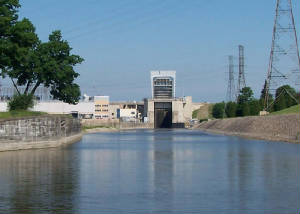
|
| The Guillotine Gate |
The Carillon Lock has an unusual design, with an entrance gate that rises and falls like a guillotine.
Once inside, we tied up to a floating dock and rode up 65 feet in 16 minutes. This modern lock was built in 1963
as part of a major hydro-electric dam project. When locks were first built on the Ottawa River, between 1819 and 1830,
it took 11 locks to accomplish what this one lock does today.
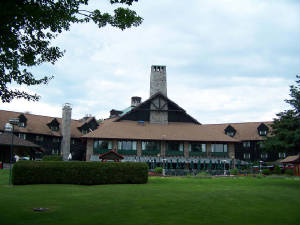
|
| Chateau Montebello |
We arrived at Montebello at a little after 2 pm, and were off to explore the Chateau Montebello soon after.
The Chateau, rumored to be the largest log structure in the world, was built as a sportsman's club in 1930, just at the onset
of the Great Depression. It took just three months for thousands of workmen laboring day and night to complete the chateau,
which has six wings radiating from its center portion. The Canadian Pacific Railway transported 10,000 logs from British
Columbia for the construction. Later the CP Railway bought the Chateau and ran it as one of their hotels. Today
it is an elegant Fairmont Hotel. It has been the site of economic summits and a NATO Conference.
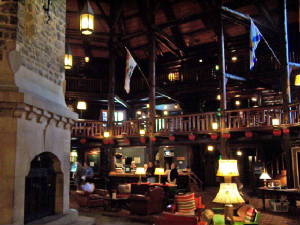
|
| Chateau Montebello lobby |
The public areas inside are reminiscent of the great lodges of the Adirondacks. The main lobby has
a massive stone fireplace in the middle with four hearths and comfortable seating all around. The ceiling is high, and
its log beam construction is all exposed. The shape is like a roundhouse, with a balcony encircling it high above,
its peeled log rails and bannisters somehow managing to communicate rustic elegance.
Next to the main building the sportsmen built themselves an Olympic size swimming pool inside a massive
log athletic facility building. Facilites for all sorts of other sporting activities -- boating, hunting, tennis, golf, and
on and on -- were part of the original Chateau, and the activity board today shows the Fairmont is dedicated to maintaining
the tradition, with tennis, golf (both 18 hole and putt-putt), paddle boats, bicycles, horseback riding, and other
special activity options.
We decided to extend our celebration of our anniversary another day and treat ourselves to the four course
gourmet table d'hote dinner.
We made a reservation, then walked back to the Marina to change into fancy casual clothes befittiing the
occaision. It started to rain just after we got back to the boat, but when Dick went up to the marina office, which
is also a hotel office, to ask about taxis, the owner offered to give us a ride to the Chateau. We took her up on her offer.
We had a table next to a window looking across the broad lawn to the river (which looks like a lake).
Our meal was exquisite, and the rain stopped before it was over. So, we walked back to the boat in the twilight along
a winding road through the woods, and declared it yet another grand day.
|
 |
|
|
 |
|
|
 |
|
|
|
|
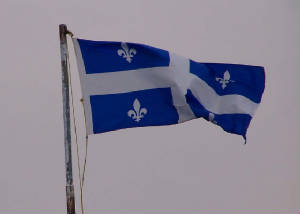
This is Quebec's provincial flag. The white cross on the blue background is like the flag of
the French Navy in the early days of the colony. The Fleur- de-lis, or white lily, is a symbol commonly associated
with France, and was on the flag that Montcalm's army flew during their victory over the British in 1858 at Fort Carillion,
now called Fort Ticonderoga (see June 9 for a summary of the battle). Because the Fort Carillon flag flew during
one of the last great French victories on this continent, it was an important symbol in Quebec.
The provincial flower was the Madonna lily, the white lily represented in stylized form by the fleur-de-lis.
In recent history, the flower was changed to the blue flag, a delicate iris which grows wild somewhere in the province.
The provincial bird is the snowy owl, who inhabits the province only in the winter, preferring much colder
climates. This time of year, you would have to go to the arctic to see a snowy owl.
License plates here carry the motto, "Je me souviens," which translates to "I remember." I remember
what? The phrase is inscribed on Quebec's National Assembly Building, on a wall with brass reliefs of figures from Quebec's
history. Referring to the wall, the phrase must mean, I remember . . . Quebec's history. For us, it will
always refer to warm memories of this beautiful land blessed with clean waters, charming towns crowned by ornate church
spires, and a rich French cultural heritage.
|
|
|
 |

